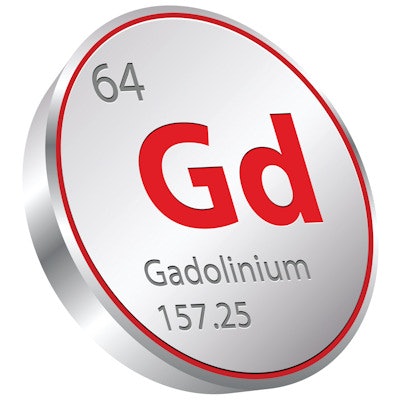
Two European researchers are forging ahead with their proposal to collect clinical experiences and outcomes with gadolinium-based contrast agents (GBCAs) and store the information in a worldwide database. The ultimate goal is to further advance research into GBCA safety, as outlined in the January issue of Radiology.
The Gadolinium Retention Evaluation Consortium (GREC) is the brainchild of Dr. Carlo Cosimo Quattrocchi, PhD, from the Università Campus Bio-Medico Rome and Dr. Aart van der Molen from Leiden University Medical Center in the Netherlands. So far, 25 researchers from eight countries in Europe and the U.S. have signed on to the initiative, along with four manufacturers of gadolinium contrast (Radiology, January 2017, Vol. 282:1, pp. 12-16).
"The plan is to make the information available through an easily accessible database where registered researchers worldwide could upload anonymized data regarding clinical, imaging, and contrast agent exposure," Quattrocchi wrote in an email to AuntMinnie.com. "Information will be structured and shared to allow for analytics later."
The great debate
Gadolinium contrast agents have been administered more than 300 million times and are believed to be "exceedingly safe," with a "very low frequency of acute adverse events," wrote the authors, noting two previous studies.
Those papers, published in 2015 and 2016, came after a December 2013 study by Kanda et al that ignited the debate over the safety of GBCAs. The Japanese researchers discovered increased signal intensity in the dentate nucleus after multiple injections of gadolinium-based contrast. Additional research soon followed, including a March 2015 study by McDonald et al that found traces of gadolinium in four areas of the brain several years after GBCA administration.
"Safety related to exposure to gadolinium is a health issue but may be considered a social challenge, too, due to the large number of contrast-enhanced MRI scans performed every day across the world," Quattrocchi said.
Diving deeper into the gadolinium retention issue, Radbruch et al suggested in a November 2016 study that switching from a linear GBCA to a macrocyclic one reduced the level of residual signal intensity in patients who underwent multiple enhanced MRI scans with both types of contrast agents.
Given the increasing amount of research and the ongoing debate over what, if any, side effects may surface from the use of GBCAs in healthy patients, Quattrocchi and van der Molen devised a plan to amalgamate all of the data into one central and accessible location.
"Right now, there are no long-term clinical effects that may be related to gadolinium retention in the brain and the body, at least in patients with normal renal function," Quattrocchi said. "However, large populations need to be explored to verify whether subpopulations may have consequences and what the risk factors are."
Funding jump-start
The key steps going forward will be "sharing knowledge gaps, developing the research agenda, and producing guidelines of methodology for clinical and preclinical studies," Quattrocchi said.
The group's ability to carry out its self-appointed tasks depends greatly on money. So far, no funding has been received, so the organizers are now actively searching for willing sources.
"Funds will be used to open and maintain the official website and the web-based infrastructure," Quattrocchi said. "Reports and guidelines will be made available to patients, medical doctors, scientific societies, and healthcare authorities."
The list of early participants in the Gadolinium Retention Evaluation Consortium reads like a who's who of GBCA research. For example, it includes the previously mentioned Dr. Alexander Radbruch from Heidelberg University, who also led a December 2016 study that found no evidence of increases in T1 signal intensity among patients who received more than 20 injections of macrocyclic GBCAs for MRI scans.
Four U.S. researchers are on board with the project:
- Dr. Robert McDonald, PhD, lead author of the aforementioned March 2015 GBCA study
- Dr. Emanuel Kanal, director of MR services at University of Pittsburgh Medical Center and advocate for MRI and GBCA safety
- Dr. Richard Semelka, director of MR services and professor of radiology at the University of North Carolina at Chapel Hill, who last year proposed new terms to describe the aftereffects of gadolinium exposure
- Michael Tweedle, PhD, from Ohio State University's department of radiology, who has co-authored articles with Kanal on the potential clinical implications of gadolinium traces in the brain
Since its inception, GREC has enlisted support from four GBCA manufacturers:
- Bayer HealthCare Pharmaceuticals, which supplies gadopentetate dimeglumine (Magnevist), gadobutrol (Gadavist), and gadoxetate (Eovist)
- Bracco Diagnostics, which offers gadoteridol (ProHance) and gadobenate dimeglumine (MultiHance)
- GE Healthcare, which provides gadodiamide (Omniscan)
- Guerbet, which supplies gadoterate meglumine (Dotarem)
"There are still open questions [about GBCA safety] that require a definite answer," Quattrocchi said. "A worldwide research effort is a valid alternative strategy to increase statistical power and at the same time overcome limitations of single-institution studies."


.fFmgij6Hin.png?auto=compress%2Cformat&fit=crop&h=100&q=70&w=100)





.fFmgij6Hin.png?auto=compress%2Cformat&fit=crop&h=167&q=70&w=250)











